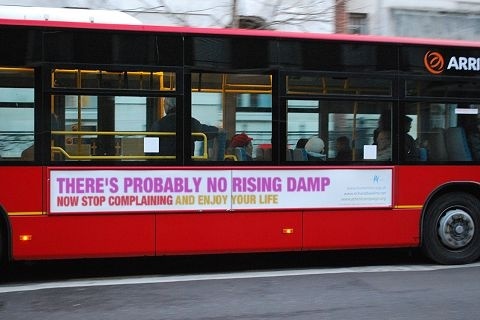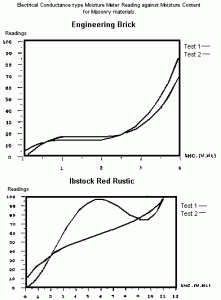“Rising damp” is a very rare phenomenon, So rare that many serious construction researchers have never seen it
Millions are spent each year in the UK “curing” the problem, but does it even really exist?
I have personally surveyed over 500 properties throughout the UK which have been diagnosed as suffering from rising damp, and I have found in every case that the diagnosis was wrong. So what is going on here? How come surveyors are finding rising damp where it doesn’t exist?
The answer lies in commercial pressures. The “surveyors” who work for damp-proofing companies are actually salesmen. They make their money by taking a percentage commission on the damp-proofing work they specify. So if you invite a damp-proofing company to inspect your home for dampness problems, you should not be surprised if they “discover” its existence. That’s how they make a living.
Damp-proofing salesmen use electrical conductance-type meters to “diagnose” rising damp. These are labelled “moisture meters”, but they do not really measure moisture. They measure electrical conductance, and will give a reading on any building material which allows an electric current to flow through it. Clinker blocks, for example, which are made from coal ash, have a high carbon content, which means they conduct electricity. So clinker blocks will always give a high reading on one of these meters, even when they are bone-dry. These meters are actually calibrated for use on timber, and they can give reasonable approximations of moisture contents in wood, but on bricks, plaster and wallpaper they give readings which are way too high, and can easily be used to give the impression that a wall is damp when it is actually in a perfectly normal equilibrium moisture state with its surroundings.
The graph below shows the readings on two electrical conductance-type moisture meters against the actual moisture content of two types of brick. You can see that there is really no relation between the meter readings and the moisture content. And yet every day thousands of surveyors and damp-proofing salesmen stick these meters into walls and solemnly declare the presence of “rising damp”!
Oh, one final thing. “Rising damp” is an advertising phrase, invented by the damp-proofing industry to sell its products. “Damp” is an adjective, not a noun. So the correct English phrase should be “rising dampness”. But that doesn’t roll off the tongue quite so easily, does it?
Rising Damp when buying a house
Q. I am in the process of selling my house. The buyer’s mortgage lender insisted on a survey for rising damp, and the surveyor’s report says that there is extensive damp in all walls. There is no evidence of damp, such as wallpaper lifting, and a recent TV programme concluded that treatment for rising damp is seldom justified. What is your advice about current practice?
A. Rising damp is a myth. The ‘surveyor’, who says there is extensive dampness in all the walls is actually just a salesmen for chemical damp-proofing products. Tell your buyers that they need an independent dampness survey carried out to the standards described in Building Research Establishment Digest 245, and under no circumstances allow them to deduct the cost of damp-proofing works from the asking price.
Conflicting diagnoses
Q. I am buying a basement flat. Under ‘essential repairs’ the valuation survey report stated: ‘You are advised to obtain a specialist rising damp report from a member of the British Wood Preserving and Damp-proofing Association, and carry out their recommendations in full. Any treatment undertaken should form part of a long-term insurance-bonded guarantee.’ On the strength of this the mortgage lender withheld some money and we have now had four quotes from BWPDA firms. All of them indicated different damp spots in different parts of the house, and their estimates ranged from £600 to £3,750. Is there any reputable contractor you can recommend who provides an independent report on damp, preferably one whose views are respected by mortgage lenders?
A. Yes. Not a contractor but an independent surveyor. In my experience, there’s no such thing as a reputable ‘contractor’. Almost all damp-proofing/timber treatment contractors make their money by offering free surveys and then saying you need work done. The unreliability of their diagnoses is underlined by the fact that, as in your case, different ‘specialist’ firms usually come up with different proposals.


